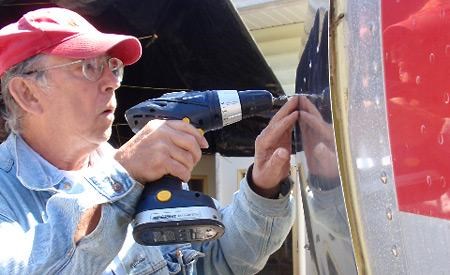A teaching aid for a Texada Island summer camp is so eye-catching that it has become a travelling attraction to promote island tourism.
During the first years of the Texada Aerospace Camp (TASC), which runs for the fourth time July 17 to 19 for youth aged 10 to 14, founder, director and camp visionary O.C. “Doby” Dobrostanski felt the program would benefit from having a flight simulator that students could use. Bari Lewis, a pilot friend, found a piece of fuselage for sale in Powell River. Dobrostanski was called and he convinced the Texada Arts, Culture and Tourism Society (TACT) that the fuselage should be purchased for that purpose. It was the main section of a passenger cabin from a Brazilian Embraer 120 aircraft with three windows on each side.
When Dobrostanski and other TASC supporters transported it from Powell River airport to Westview ferry terminal for travel to Texada, they noticed that it “turned heads” all along the route. “People stopped and stared,” said Dobrostanski. “Just the bare bones fuselage generated so much public curiosity that we figured with a realistic nose section, a proper tail and a great paint job, the structure would really draw a crowd.”
Tourism has markedly decreased in recent years on Texada and in the Powell River region generally due to rising ferry and fuel costs. Additionally, Dobrostanski said he recently spoke with a Vancouver Island radio reporter and “the person had no idea where Texada was. We’re a too-well-kept secret.”
Together with a team of passionate volunteers, Dobrostanski, a retired aircraft technician and technical writer, and now a local artist, modelled the nose section after a Dakota DC3. The tail section design is a combination from the vintage aircraft flown by the Fraser Blues precision-flying team, which visits the Texada Fly-In each July at Gillies Bay airport, and a C-130 Hercules. This year, the Fly-In takes place July 20. Proudly, he said, “It was all put together by hand.”
Nicknamed “AirBuzz,” its maiden voyage took place Sunday at Powell River Lions Club’s hot dog roast at Town Centre Mall. Dozens of people, including City of Powell River Mayor Dave Formosa, came by to see the mock aircraft and chat with Dobrostanski about what the structure was and about TASC. “Many people just leaned out of their car windows and took photos,” said Dobrostanski. “Though it’s not yet equipped with tourist information, so many adults were interested in TASC, we may put on another session for them.” The Sunday appearance confirmed that AirBuzz is as eye-catching as its creator thought it was.
It looks like a small, wingless aircraft, consisting of a metal and wood combination cockpit and realistic tail section, attached to the airline fuselage. Below the tail is a ramp which is raised and lowered to reveal a tourist information kiosk inside. When fully outfitted, in the interior video monitors will show information about Texada, its events, history and amenities and a display rack will be loaded with printed material.
The unique and imposing AirBuzz structure is highly visual and TACT hopes to display it throughout the summer at special events, tourist venues, community festivals and parades throughout the Upper and Lower Sunshine Coast, Vancouver Island and Texada. TACT president Bob Timms believes it will attract attention and spread awareness of Texada as a tourist destination.
As funding permits, videos about Texada will be projected through the plastic AirBuzz nose to the exterior of the craft. Exterior flashing lights will also be added. Panels along the lower parts of the assembly will carry paid advertising to help defray travel costs.
Specifications
Length: 26 feet
Diameter: 7.5 feet
Height: 15.5 feet including the tail, which can be removed for travel
Weight: about 900 pounds
Exterior: aluminum
Pulling it all together:
As a teaching tool, AirBuzz contains flight instruments, most of which were donated by private aircraft owners and pilots, the Chilliwack Experimental Aircraft Association Chapter 1447, and KD Air. Texadan Sandy Simms built all of the electronics including the flight simulator where the on-screen visual turns in sync as the controls are moved. Other major contributors to the development and construction of AirBuzz include Dick Fahlman, who helped design the construction process of the nose and tail sections; Harvey Johnson, who welded and fabricated the skids AirBuzz sits on; Jack Oosten-Brink, who created the authentic-looking DC3 engine control panel; Gerry Johnson, who contributed hundreds of hours of carpentry for the nose and frame attachments (Johnson also hosted the construction project at his Gillies Bay home); Peter Teuner, Dale Rinehart and Bari Lewis who worked on the airframe and ramp mechanicals; Steve Croasdale, exterior graphics and Maurice Brunelle and Pete Stiles for transportation assistance.
Financial supporters include First Credit Union, Powell River Lions Club, Westview Realty, Powell River Regional District, TACT, Texada Transfer, RONA Building Centre and Lafarge Canada.



